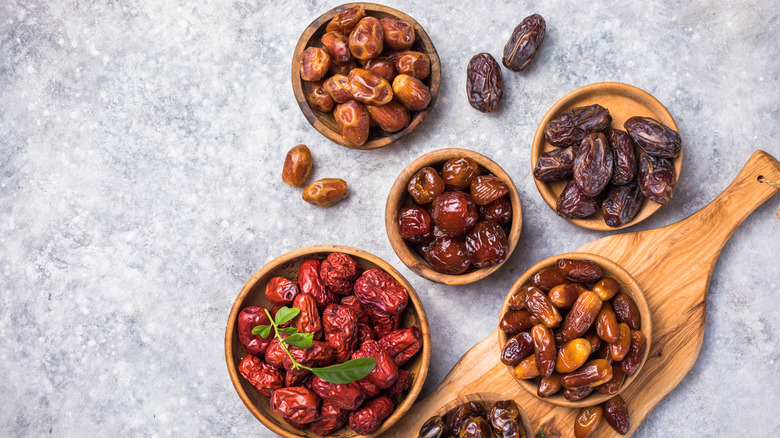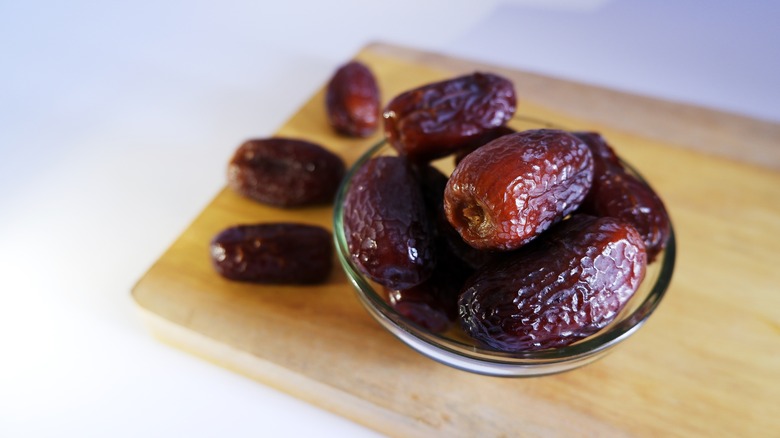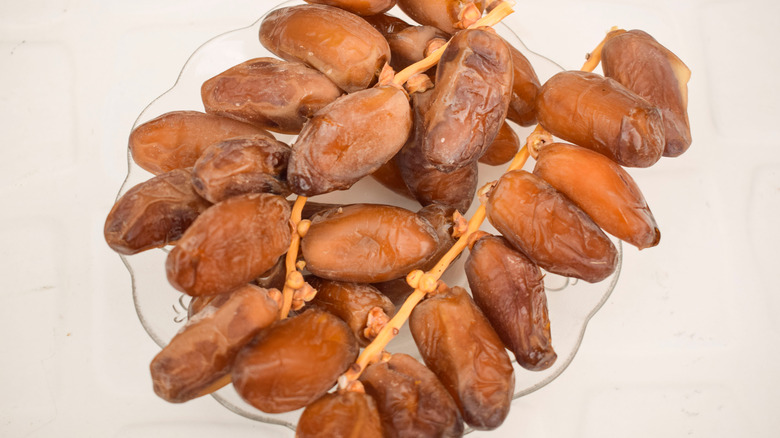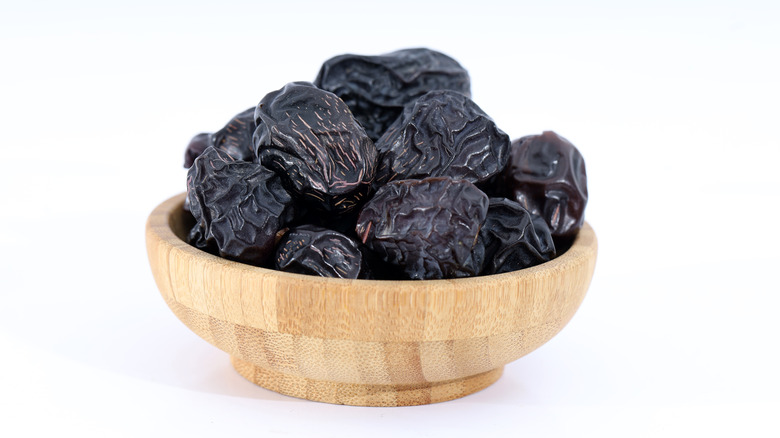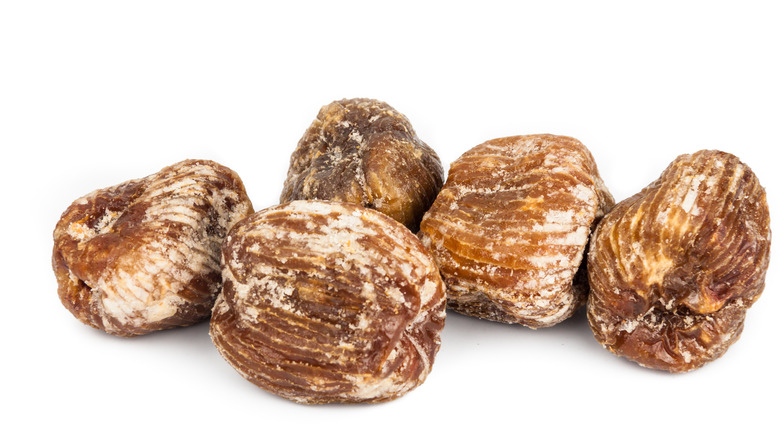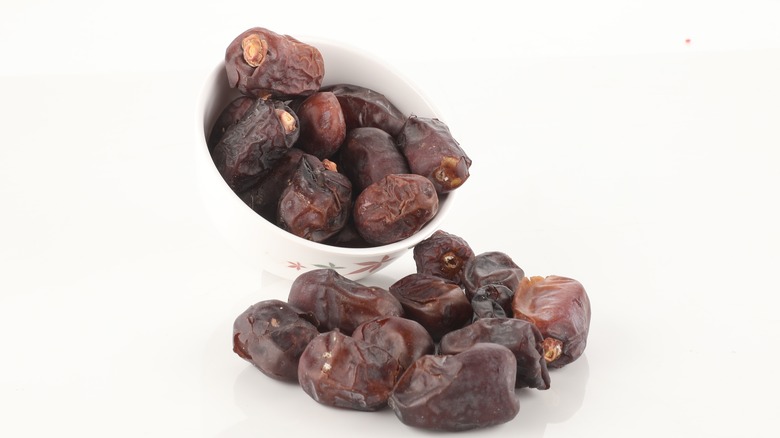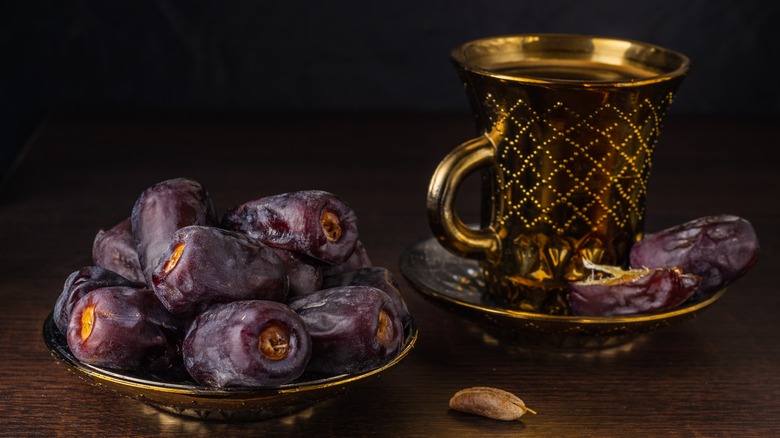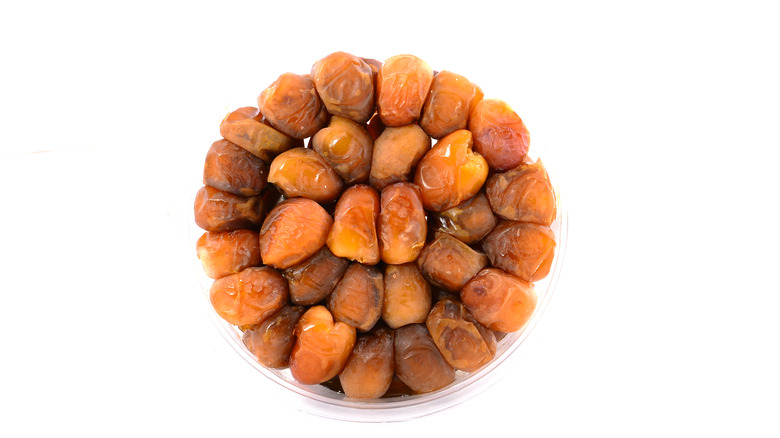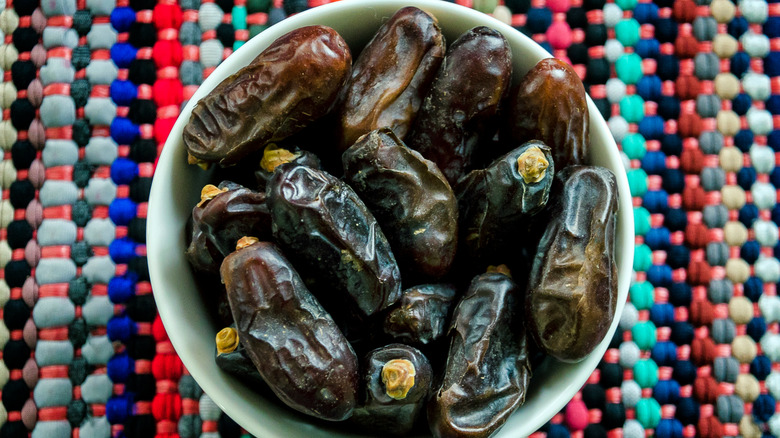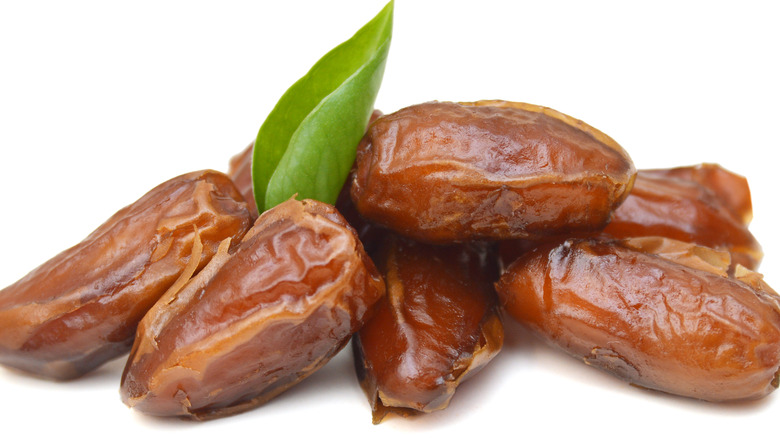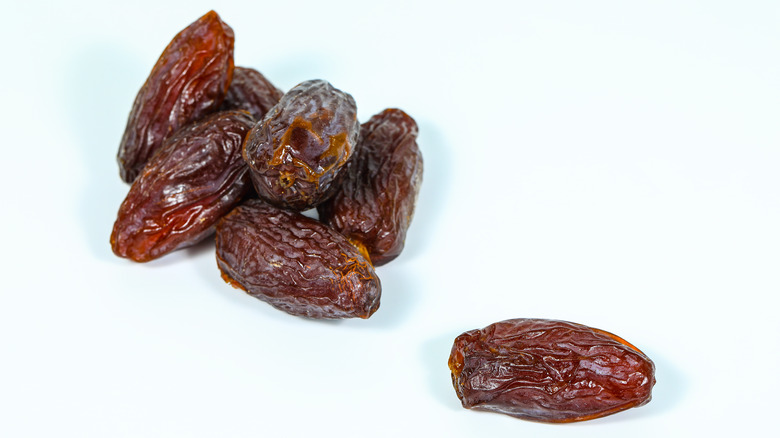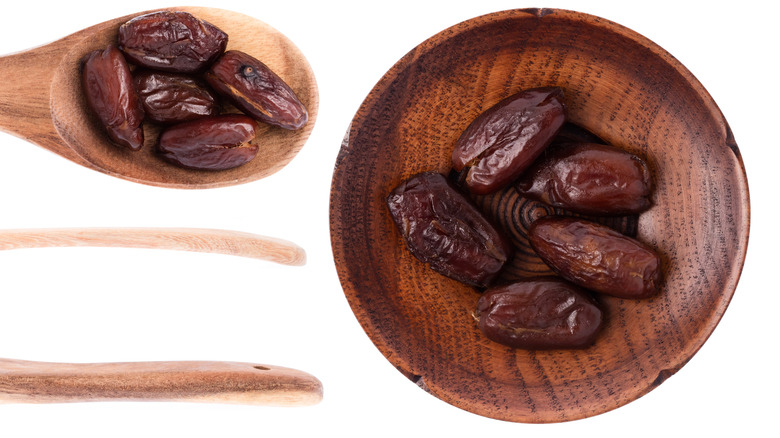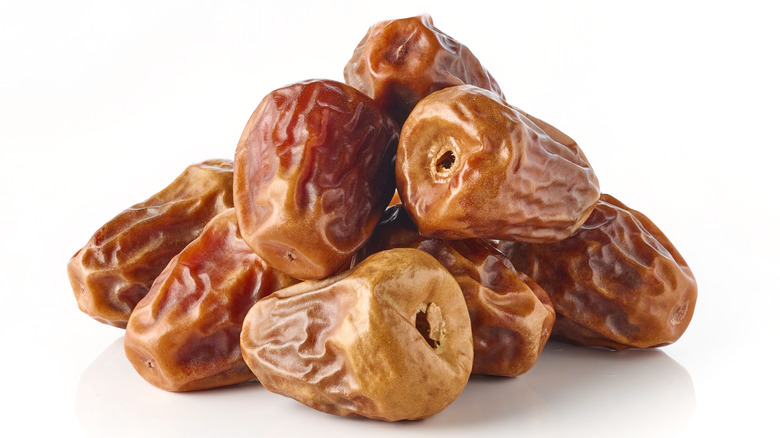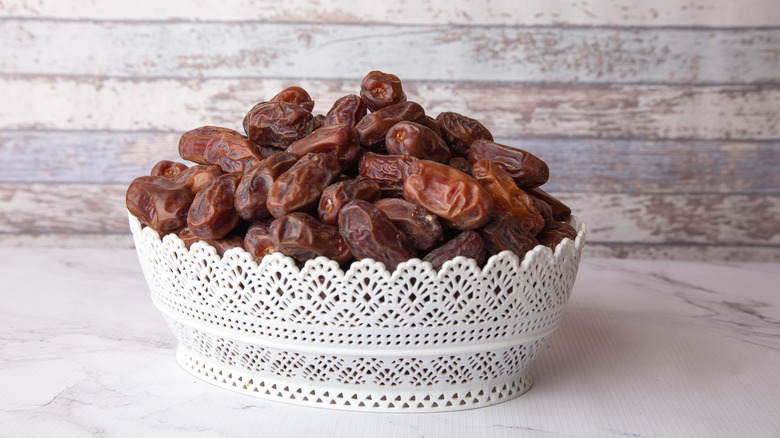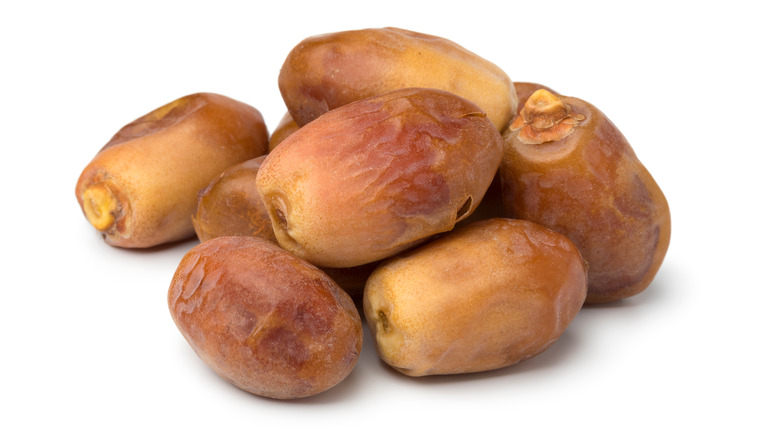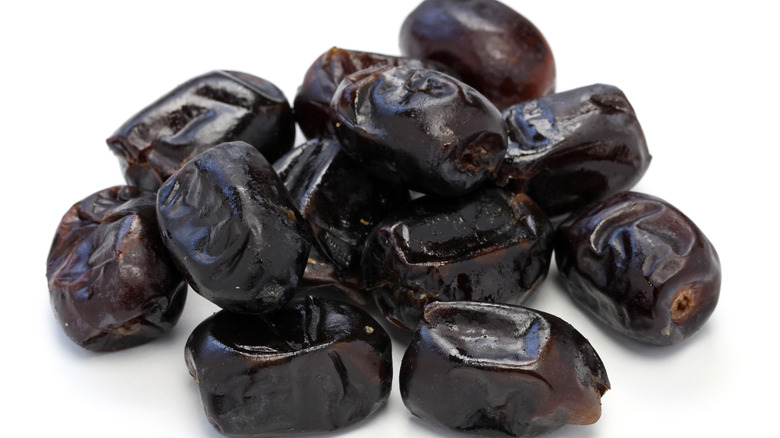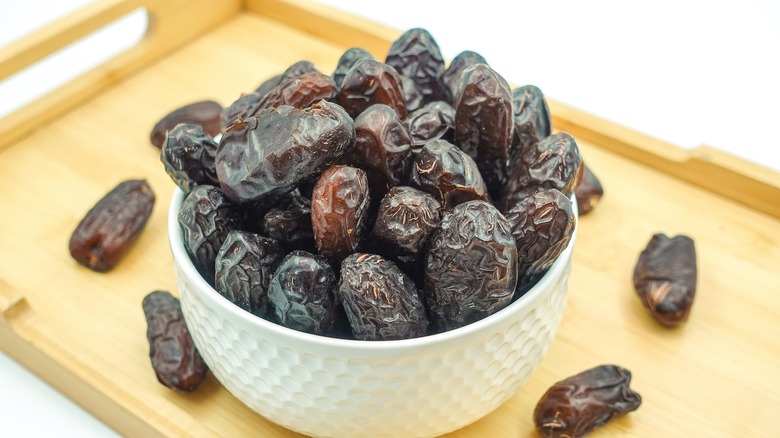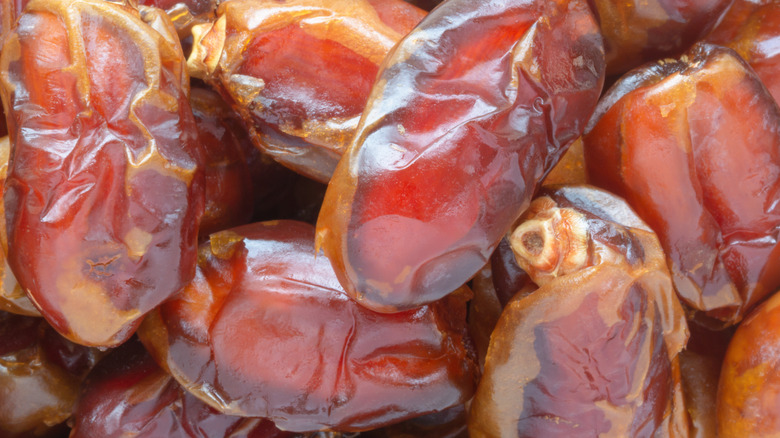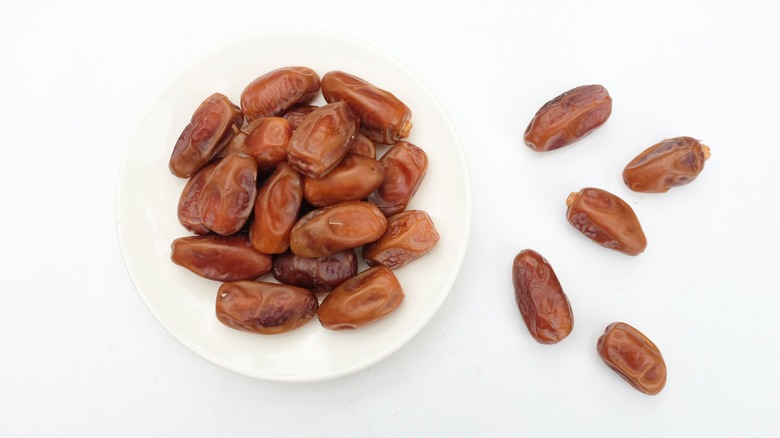18 Types Of Date Fruits, Explained
A fruit with a long history and a wonderful tradition, the date has been eaten for over 6,000 years. Originally cultivated in the Middle East, dates are now grown in other parts of the world, such as the U.S., North Africa, and Asia. Dates are the fruit of a variety of palm trees that must be hand-pollinated and carefully monitored to harvest the best dates.
Dates have a rich spiritual tradition in the Muslim world and are also consumed for medicinal purposes. The caramel-like fruit is rich in potassium, magnesium, copper, manganese, and iron. Due to their natural sweetness, dates are used in various recipes. They can be combined with other dried fruits but are very different from plums and similar fruits, primarily because of their sweetness. They also have a long shelf life (you can keep them for up to 18 months), but ensure you always check dates for signs of going bad. Whether you want a quick snack or wish to cook with them, it's good to know the various types of dates available.
Medjool dates
Medjool dates are among the most popular varieties because of their sweeter-than-average taste and larger size. Like other dates, medjool dates are the fruits of palm trees. This variety is native to Morocco, but nowadays, it is grown in many other parts of the world, such as the U.S., the Middle East, South Asia, and Africa. As they are often sold dried, medjool dates are softer and stickier than other date varieties, which makes them easier to use in specific recipes. In addition, medjool dates contain more sugar than Deglet Noor dates, and they also pack lots of fiber, which makes them an excellent ally in promoting healthy digestion.
You can use medjool dates in a recipe, such as roasted dates with pancetta, as the fruit's soft texture contrasts nicely with the crisp pancetta and almonds, and the sweet taste makes a great combination with the salty pancetta. To make the recipe, heat the dates in the oven, cook the pancetta in a pan until crisp, then add the almonds, garlic, red pepper flakes, and stock. Complete the dish with butter, lemon juice, and fresh parsley, then add the dates to the pan and cover them with the sauce.
Deglet Noor dates
Deglet Noor is probably the best-known date variety, as their firm texture makes them easier to use in cooking than medjool dates. This date is versatile and can be integrated into many recipes, from fine dining dishes to simple bakery products or traditional cuisines. Deglet Noor dates can be yellow or amber and have firm, semi-dry flesh. The Deglet Noor date is ideal for making date sugar, syrups, or baking pastes and can also be used in cookies as it maintains consistency.
Use Deglet Noor dates in recipes, such as bacon-wrapped dates with Parmesan, in which contrasting textures and tastes collide for a spectacular dish. To make this, stuff the pitted dates with Parmesan cheese and wrap them in thinly sliced bacon. Then, cook them in the oven until the bacon is crispy, and sprinkle them with fresh parsley before serving.
Try a lamb tagine with dates and almonds if you want a more traditional dish. Cook onions and lamb until browned; add turmeric, ground ginger, cinnamon, and season with salt and pepper, then cover with chicken stock and bring to a boil. Simmer for 1½ hours until the meat is tender. Add the dates, ginger, almonds, honey, and brown sugar, then simmer for another 30 minutes. Serve the lamb tagine with rice or orzo pilaf.
Ajwa dates
Ajwa dates represent a date fruit variety that is very popular in the Middle East, especially in Saudi Arabia. They originate from Medina in Saudi Arabia and carry spiritual meaning. Ajwa dates come in darker shades than medjool dates or Deglet Noor dates, as they are blackish and round. Their texture is firm, and the taste is reminiscent of chocolate, amber, and caramel. Ajwa dates are rich in potassium and fiber. They also contain folate and riboflavin and can be moderately consumed by people with diabetes.
Ajwa dates are smaller and less sweet than medjool dates, so they probably won't provide as much sweetness when used in smoothies. However, add them to a strawberry banana smoothie if you prefer something less sweet. You can also use them to sweeten Columbian medium-roast black coffee or Moroccan mint tea. Or, if you want a sweet snack that is also healthy, try some ajwa dates with a few pieces of dark chocolate. You can store ajwa dates in an airtight container for up to three months or keep them in your fridge for up to six months.
Honey dates
Honey dates is the generic name given to a soft date fruit variety with sweet tones resembling honey. The numerous honey date fruits share a few taste, texture, and color features but also differ in some aspects. For example, they can have a light caramel color or deep brown hues, are softer than most date varieties, and have a buttery texture. Most importantly, their mild taste is reminiscent of honey and can range from a bitter, molasses-like flavor to wildflower honey.
Honey dates are a great natural sweetener for cookies, cake batter, ice cream, and oatmeal. Due to the soft texture, they will melt into caramel sauce. Honey dates work well when paired with chocolate, maple syrup, cinnamon, nutmeg, cardamom, butter, coconut, orange, ginger, and dark rum. They can also be used for savory dishes when paired with poultry, pork, and bacon. You can even use honey dates to sweeten pancakes and brownies.
Piarom dates
Piarom dates are an Iranian date variety from the mountain region in the country's south and are known internationally as chocolate dates. Because the palm tree that produces them only grows in the mountainous regions, there are few areas where they can be planted, which makes piarom dates one of the most expensive date varieties you'll find. These dates are usually harvested from October to November. Piarom dates are dark brown, with a thin skin and chocolate flavor. Piarom dates have fewer calories than other date varieties, which makes them a good option for people with diabetes.
Piarom dates can be consumed alone but can also become part of some delicious dishes. They have a low moisture content, meaning they have a longer shelf life when stored in an airtight container. Use them to sweeten your morning cereal, puddings, bread, cakes, and cookies or for a healthier ice cream twist. Piarom dates are also used to make date sugar, which presents certain benefits compared to sugar cane sugar.
Mazafati dates
Mazafati dates are another Iranian date variety. They belong to the wet date category, as they have high moisture content, which is one of the quality indicators in mazafati dates. Fresh dates, harvested at the beginning of September, tend to retain the highest moisture levels and are the most expensive. Depending on the moisture levels, there are three types of mazafati dates: fresh dates have about 30% moisture, semi-dry dates have 20-25%, and dried dates have 16% moisture.
Mazafati dates are usually black and have thin skin, which can be easily removed. The taste is very sweet, and they can act as a sugar substitute. Another unique quality of mazafati is that they pack more iron than other date types, which can promote healthy hair growth. Aside from iron, mazafati dates contain phosphorus, potassium, calcium, and magnesium and are beneficial to developing the nervous system and lowering cholesterol. They also have many calcium, magnesium, potassium, and vitamins, such as A, B complex, and C.
Barhi dates
Barhi dates are a formerly overlooked variety of date fruit, originating from Iraq and belonging to the soft date subgroup. Today, Barhi dates are cultivated in the U.S., in the Californian Coachella valley, where date palms thrive due to underground water sources. Barhi dates are best known for their resemblance to butterscotch candy when ripe, but they present lots of flavor undertones as the fruits ripen.
Barhi dates have three ripening stages, each with different tastes and textures. A unique quality is that they can be consumed in all three maturity stages. The khalal stage means semi-ripe and presents a crunchy, somewhat astringent fruit that can be incorporated into salads. The rutab stage is the semi-ripe stage, in which the fruit has a creamy consistency. The dates can be used in this stage to sweeten syrups, pastes, sauces, and wine. Finally, the tamr stage means the fully-matured fruit; when the sweetness is at its finest, the fruit develops a unique caramel flavor. Bahri dates make a good combination with oranges, bananas, coconuts, cinnamon, maple syrup, and different nut and cheese varieties.
Rabbi dates
Rabbi dates are native to Iran and one of the country's most important agricultural products. They have a long, oval shape and are primarily reddish in color, a feature that sets them apart from other date varieties. In addition, rabbi dates are semi-dry dates, so they have a low moisture content, which means that they also have a longer shelf life.
Rabbi date trees only grow in two regions in Iran and are exported worldwide. The most significant demand is in Central Asia, India, and Pakistan. The area producing rabbi dates has a long history of cultivating date palms, over 2,000 years. Rabbi dates are rich in fructose and lactose and suitable for consumption by persons with diabetes or high blood pressure. Eating rabbi dates may help digestion because of the high fiber content and might aid those with anemia, as they have a high mineral content. In addition, the seed inside Rabbi dates is rich in antioxidants and is used to make date seed oil, which is used in the cosmetic industry.
Sayer dates
Sayer dates are another date fruit variety that only grows in Iran. They are cultivated by the farms surrounding the city of Shadegan, where the rich soil of the valley and the proximity of two significant rivers make the area an essential source of date fruit. Sayer dates are one of the sweetest date varieties in the world, with a sugar content of about 75%. The sugar concentration is similar to piarom dates.
Sayer dates have a light brown color and soft flesh that tastes like caramel. In Iran, they are sold both in their pitted and unpitted form. Pitted dates are easier to use in industrial preparations, such as biscuits, confectionery, and vinegar. Sayer dates can be used for two years, as they have a moderate moisture level. They can also be rehydrated by adding a little water to a container and keeping them in the sun for a short period. Sayer dates can be consumed as-is but are also used as a sweetener in pastries, desserts, and ice cream.
Dayri dates
Dayri dates are native to the region of Basra, Iraq. Over time, the palm tree that produces them was naturalized to other parts of the world, so nowadays, they are also grown in the U.S. Dayri dates have an oval shape, consisting of a single seed covered in soft flesh. They are dark brown or black and lack the fibrous texture of some other date varieties. Also, they are less sweet than medjool dates. Dayri dates are harvested in late fall, and their earthy flavor is also perceivable as they are not as sweet as other dates.
This date fruit variety is suitable for sweet and savory dishes. They can be consumed as such, but they are also great for stuffing, as they come in large sizes, and their taste works excellently against the saltiness of bacon or the creaminess of goat cheese. Dayri dates can be used as a sweetener, and turning them into a paste is effortless. The paste goes well with ice creams, smoothies, and oatmeal. An excellent idea for a snack is spreading the date paste on a piece of bread and sprinkling it with salt.
Halawi dates
Halawi dates are also native to Iraq and were naturalized in California at the beginning of the 20th century. "Halawi" is the Arabic word for "sweet." These dates are indeed sweet, with a butter and caramel flavor resembling a pecan pie taste. Halawi dates have a honey-like color, thin skin, and an elongated oval shape.
Halawi dates are classified as a semi-dry date variety, and they are sometimes used in other maturity stages, for instance, when they are not fully ripe, firmer, and less sweet. However, most producers harvest them only when fully mature because they have more uses. Halawi dates maintain their strong consistency when chopped or diced as they are moderately fibrous dates. You can use them for baking, as they won't become too soft, and you can also stuff them with cream cheese and nuts. Although they are less pliable than medjool dates, Halawi dates can substitute that variety successfully. They work well with flavors such as nuts, chocolate, coffee, cream, cinnamon, coconut, orange, brandy, rum, and others.
Sukkary dates
Sukkary dates are traditional Saudi Arabian date fruit and only grow in the Al Qassim region. They are very sweet and soft, with a honey-like flavor and a light brown color. Sukkary dates are sometimes called "royal dates" because of their exquisite taste and texture. Like most date palm trees, sukkary date palm trees are hand pollinated by farmers to increase date fruit production.
Sukkary dates are a part of the Iftar tradition. Iftar represents the fast-breaking meal during Ramadan, and it traditionally includes dates, as they have a lot of spiritual meaning. A great way to enjoy sukkary dates is to serve them with cream and nut stuffing. The dates pair well with nuts like almonds, cashews, pecans, and walnuts. The stuffed dates are often flavored with lemon zest and candied ginger, as the tastes go well together. Of course, they can also be enjoyed as they are or combined with other foods when making complex dishes.
Khudri dates
Khudri dates come from the Arabian Peninsula, much like other date varieties. However, they are smaller, have a reddish, white, or black color, and have a soft and chewy texture. The red khudri date is the most common type and is widely used because of its sweetness and texture. On the other hand, the black dates pack more iron than the red and white varieties and come with a slightly bitter flavor. The white date variety is mild and offers a very delicate taste.
Khudri dates are not as easy to find as other varieties, and they are slightly more expensive. Khudri dates should be stored around 60 degrees Fahrenheit in a dark, dry place. When kept in the fridge, dates should be wrapped in plastic to maintain moisture. If they are kept in a container, placing rice underneath them might help absorb moisture and prevent the dates from drying out prematurely.
Zahidi dates
Zahidi dates are the fruit of a palm tree that is very valued for landscaping. In addition, the dates preserve their shape, so they are suited to be exported. Zahidi dates are native to Iraq, but today, they are also grown in Djibouti, Chile, India, Syria, and the U.S. The date fruit has a medium size, round shape, a golden color, and tastes sweet and nutty. The texture of the zahidi date is somewhat chewy and semi-dry, and the taste is buttery and reminiscent of dried apricots.
Zahidi date palm trees can produce up to 136 kilos of fruit in one season, making this variety one of the most prolific date palm trees. With its chewy texture, the zahidi date is excellent for baking, as it will maintain its integrity when cooked. In addition, these dates can be used in sweet and savory recipes because they are not as sweet as other varieties. For example, try making some sesame almond balls in which the buttery taste of the zahidi date is perfectly paired with sesame and almonds.
Safawi dates
Safawi dates are another date variety grown in Saudi Arabia in Madinah. They are dark black, larger than usual, and similar to medjool dates. These dates originate from a very productive date palm variety, so safawi dates usually cost less than other date fruit varieties. Also, because of the palm tree's productivity, safawi dates are available all year. According to Oasis Date, safawi dates have multiple health benefits and have been used in traditional medicine for centuries.
Probably the most important of these health benefits is how safawi dates sustain the functioning of the digestive tract. With a high fiber content, they are a great relief for constipation or as a general cure for intestinal disorders. In addition, the balanced fiber and nutrients in safawi dates make them a good remedy for diarrhea. As they are low in fats, safawi dates are also beneficial for the heart, and the high iron content makes them suitable for anemic persons. Although they are similar to medjool dates, safawi dates have a lower sweetness level, which makes them better suited for persons with diabetes.
Kimia dates
Kimia dates are often grown in southern Iran, and are particularly common in Bam, a city in the Kerman province. Kimia dates are considered to be of superior quality, so they're typically more costly than other varieties of dates. The higher price point might be worth it, though, especially if you're planning to gift the fruit or serve them at a special celebration.
This type of date starts out with a deep purple color but becomes black during the ripening process. Its skin is often smoother than other dates, and due to its high water content, the kimia date has a soft and meaty texture. The exact level of moisture in each date depends on when it's harvested, which can happen anytime between early August to the end of October. Due to the soft consistency of Kimia dates, they'll puree fairly easily in a blender, making them an excellent option for sweetening smoothies.
Omani dates
Omani dates come from Oman, a country that borders Saudi Arabia, Yemen, and the United Arab Emirates. As one of the world's leading producers of dates, it's no surprise Oman is home to more than 250 varieties. The most popular ones are khalas, farth, and khunaizi dates, each of which has unique characteristics. Khalas dates are yellow when fresh and caramel-brown when dried. Farth (or fard) dates are the most common type in Oman, and have a chocolate hue and are somewhat tender. Khunaizi dates are big, red, and exceptionally sweet.
Additionally, there are two types of Omani dates: table dates and manufacturing dates. Table dates can be eaten raw by humans, while manufacturing dates cannot. These varieties are used for animal feed instead. For the dates that can be consumed by people, they hold a significant role in the country's culture. You'll find them served with coffee at virtually every event, from weddings to casual gatherings.
Thoory dates
Thoory dates, also known as thuri dates, are thought to hail from Tolga, which is located in the Biskra province of Algeria. However, they're also grown in California. Thoory dates are the driest variety; in fact, the texture is so similar to a pastry that they're also called bread dates. If you're lucky enough to find thoory dates but prefer a softer consistency, try soaking them in water before enjoying. Otherwise, the dryness might be ideal if you're looking for dates that aren't too sticky.
In addition to its tough and dry texture, thoory dates are known for their nutty taste. The flavor is somewhat reminiscent of cashews and peanuts, making it a delicious addition in recipes such as granola, trail mix, and various baked goods. In smoothies, they work well blended with nut-friendly ingredients like bananas and oat milk. As for appearance, thoory dates are wrinkly and have a light brown-gold color.
